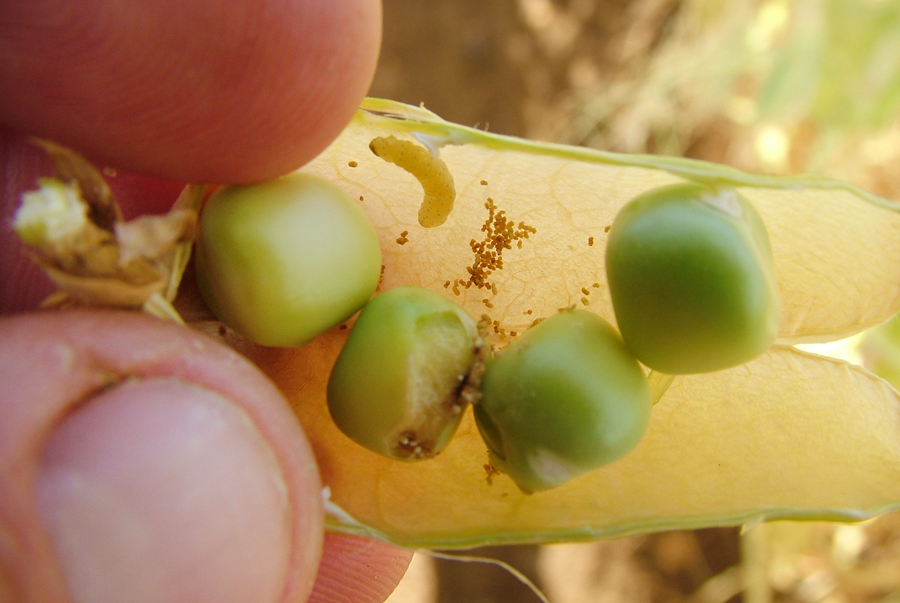Pest monitoring: Bean seed fly and pea moth
2nd April 2020
According to the Processors and Growers Research Organisation (PGRO), when it comes to serious infestations of bean seed fly (Delia platura), plant loss at seedling stage may be high, often resulting in re-drilling and loss of production of high value crops at an early growth stage.
According to the Processors and Growers Research Organisation (PGRO), when it comes to serious infestations of bean seed fly (Delia platura), plant loss at seedling stage may be high, often resulting in re-drilling and loss of production of high value crops at an early growth stage.
Bean seed fly has been identified as a high priority for UK vining peas, picking peas and Phaseolus beans (green and runner beans), as well as in alliums, asparagus and leafy salads, due to increasing incidents of damage and the loss of key active insecticidal substances. To help map the distribution and timing of bean seed fly attacks, PGRO has developed a section within the organisation’s app in which growers and agronomists can record the incidence of bean seed fly larvae or damage in any crop.
The PGRO App is free and available from Apple and Google Stores – to download the app for free, search PGRO Pea and Bean Guide within the Apple and Google stores. The link to the bean seed fly recording page is shown on the opening page of the app, so click on bean seed fly and select the crop type that you’re growing or working with. If the crop is not a legume crop, select ‘other crops’.
As you follow the links, you will reach the page where you can create a report, and here you can enter the farm name, field name and any additional notes you have about crop type, level of infestation or damage. You can add photos to the report, and it will geolocate you if you’re able to provide the report from in-field, or you can add a postcode if you’re reporting the pest from your office. The data will be used only for the purposes of the project and the report will be visible at http://pgroapp.org/. No personal data will be published.
Adult flies are attracted to freshly disturbed soil containing debris from previous crops, high levels of organic matter such as farmyard manure, or weed debris. Eggs are laid on the soil surface and larvae hatch after a few days and feed on newly planted seeds or plant and crop debris. After 10-14 days, larvae pupate and emerge as a second generation of flies, which move to suitable feeding sites. There may be several overlapping generations per year, occurring from late spring until early autumn.
Seed of later planted peas or beans is attacked during germination and larvae feed on newly planted seeds and seedlings, tunnelling into freshly imbibed seeds and the stems of small seedlings. Bean seed fly affects more than 40 different host plants and hosts include Phaseolus beans, peas, broad beans, cucumber, melon, spinach, onion, pepper, potato, maize (alfalfa, cotton, strawberry and tobacco are secondary hosts) and the larva is a common pest found in most temperate countries.
As part of The Horticulture Strategic Centres for Field Vegetables, PGRO seeks to provide, with the help of growers, information about the distribution of the bean seed fly (Delia platura) across the UK in all affected crops.
Pea moth
Pea moth is one of the most damaging pea pests in this country and Europe. The caterpillars feed on peas within the pod. In vining peas, there is a risk of crop rejection because of contamination of the produce by damaged peas which cannot be removed mechanically. In combining peas for premium markets including human consumption or seed, damaged peas are removed by the merchant and the price paid to the grower is reduced in proportion. Although moth damage can reduce quality, the yield loss is rarely significant and the presence of damage in peas for animal feed compounding is not important.
Control in these crops may only be justifiable where the damage levels in previous crops have been high. Spraying should be related to the development of the insect rather than to the stage of growth of the crop, therefore insecticides should be applied while the larvae are exposed – that is, from the time of hatching to the time of entering the pods. The timing of application is critical for maximum control. Since pea moth can be a localised problem, overall spraying of peas over a wide area on any one date is not advisable as local conditions influence the behaviour of the pest.
A system of accurately timing the application of insecticides is commercially available in the form of pheromone traps. These traps, when placed in a pea field, attract male moths and by monitoring the catches in the trap, a grower can decide whether there is a need to spray, and time any necessary spray application efficiently on their own farm.

